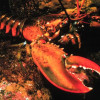Secrets of flight
Interview with
Protruding from the heads of most insects are pairs of antennae, which are  decorated with nerve endings sensitive to cues like smells and pheromones. But, in bees and possibly other insects too, these antennae also serve another crucial role: in flight. Sanjay Sane at the Bangalore National Centre for Biological Sciences spoke to Chris Smith about the discovery.
decorated with nerve endings sensitive to cues like smells and pheromones. But, in bees and possibly other insects too, these antennae also serve another crucial role: in flight. Sanjay Sane at the Bangalore National Centre for Biological Sciences spoke to Chris Smith about the discovery.
Sanjay - What we noticed was that insects position their antennae in a very precise way when they're flying. What we further noticed was that as you get them airflow, they begin to position their antennae farther. It does appear as if the bees are very concerned about where their antennae are. Antenna position itself is being influenced by airflow coming from the front as well as flow of the visual field across its retina.
Chris - Now, if you look at other social insects - things like ants - people have in the last decade shown elegantly by chopping the legs of ants actually and sticking on pig bristles, the ants count their steps to work out how far they are traveling. Are you saying that these insects, things like these are using how their antennae interact with the air flowing past them to give them a gauge of perhaps how fast they're going.
Sanjay - Something similar to that. What we are arguing is that insects have a sense of how fast they're flying because they're getting feedback from multiple sensors on their body. They're getting feedback from their eyes and they're getting feedback from their antennae. What they are able to do is calibrate across the centre. So they're using what's happening over one sense to calibrate what's happening across other sense. In that sense, they're similar to what the ants are doing with the step counting. What ants are doing is looking at the flow of their retina and at the same time counting steps and they can then correlate one with the other.
Chris - How did you actually do this study on these bees?
Sanjay - We did it in two ways. The graduate student who worked on this, the graduate student who worked on this, trained bees to come into a wind tunnel inside the lab. And so, the bees had to fly across about 100 metres from the aviary to our window then walk across a little yellow tape and go to a field. While they were doing that, we could change the airflow in the wind tunnel and at the same time, film their antennae and then what we did was look at how in terminal position as a function of the airflow.
Chris - And how are they positioned?
Sanjay - The antennae positioned forward. The base of the antennae muscles and these muscles are causing the antennae to position forward as the bee experience this air flow.
Chris - And so, this gives the bee the ability to compensate for forward air flow? Is it flies into the air or experiences ahead wind? It can adjust the position of its antennae.
Sanjay - It adjusts the position of the antennae. Why it does it is not very clear. In their approved hypothesis, one is that they're trying to keep in the range of their sensitivity. The site of extremely sensitive organs on the antenna called the Johnston organs, what they're trying to do is sense the environment using these Johnstons. So, they would want to keep those in certain range of sensitivity. That's one hypothesis. The other hypothesis is to minimise drag on the antennae. Although that hypothesis can be discounted because we've also shown that as the scenery moves over its retina, the bees position their antennae backward. The resultant of these two opposite reactions is that the antenna stays more or less in place.
Chris - So, that would fit with the idea that they are tuning the position of their antennae in order to sit there at the most sensitive position so they're getting the most accurate reading of how the air is interacting with their antennae as they fly.
Sanjay - Exactly, right.
Chris - Quite neatly, what this does is it means that even if the bee is flying into a headwind - so there's an apparent wind because of it moving but then there's an additional wind effect - then because there'll be a disparity between what the antennae record and the what the eyes record, the bees can compensate for that, I would anticipate.
Sanjay - Yes, that is exactly right. That's exactly what we think.
Chris - And if you disable this mechanism, did the bees go off course?
Sanjay - They cannot fly. They can try and take off, but they tumble and they fall and they simply cannot fly. The position of the antennae is a very necessary part of flight.
- Previous Lost generation
- Next Green drug factories










Comments
Add a comment